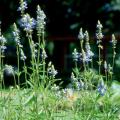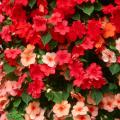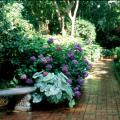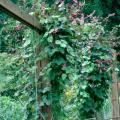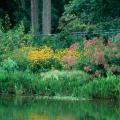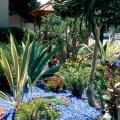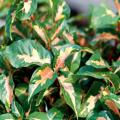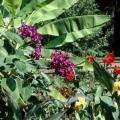Southern Gardening from 2004
By Norman Winter
MSU Horticulturist
Central Mississippi Research & Extension Center
If I remember correctly, it was Juliet who wondered, "What's in a name?" When it comes to flowers, a name can be quite important.
Take, for instance, one of my favorite salvias, the bog sage. This beautiful, sky blue, spiky flower has to suffer the indignation of being called the bog sage.
By Norman Winter
MSU Horticulturist
Central Mississippi Research & Extension Center
In the last 10 years in Mississippi, I have witnessed an incredible explosion in the petunia's popularity. Growers love its toughness and much longer season of performance.
Petunias make great landscape plants that you can set out any time during our growing season, even in the fall. So if you find high-quality transplants at the garden center, don't hesitate to buy and plant them.
By Norman Winter
MSU Horticulturist
Central Mississippi Research & Extension Center
If you thought masses of single-colored daylilies wouldn't put on a show, look around because it's happening everywhere. The daylily has risen to star landscape status, and I'm not just talking about Stella d'Oro.
Whatever color scheme you want to use, mass-planting daylilies can add sizzle to the flower bed when combined with annuals or perennials, or used in drifts in front of evergreen shrubs.
By Norman Winter
MSU Horticulturist
Central Mississippi Research & Extension Center
I made the drive to Aberdeen a few days ago and was amazed at the iridescent orange along the roadside.
There's no missing this bright orange whether you are driving the Natchez Trace or some busier thoroughfare. It also will be noticed by the Monarch butterfly. The plant is the native butterfly weed Ascelpias tuberosa.
By Norman Winter
MSU Horticulturist
Central Mississippi Research & Extension Center
After two recent trips, I remain convinced that the most striking plant for shade gardens is the hosta.
Though summer is officially just beginning, you have to admit the heat is stifling and making you head to the shade pretty quickly. If you are going to stay outdoors in Mississippi, hostas make it seem cooler and tranquil.
By Norman Winter
MSU Horticulturist
Central Mississippi Research & Extension Center
Every time I give a seminar, someone wants to know what flowers they can plant in the shade. I always answer first with impatiens. The impatiens is related to the old time touch-me-not and originates in East Africa.
When you consider that impatiens bloom from the time you plant them in the spring until the first hard frost, you are talking about an extremely good value for your landscape dollar. What other plant can you name that blooms for an average of 210 days?
By Norman Winter
MSU Horticulturist
Central Mississippi Research & Extension Center
By Norman Winter
MSU Horticulturist
Central Mississippi Research & Extension Center
When the intense heat of summer sets in, we often find it is tropical plants that explode with color around the home. One of the most floriferous is the bougainvillea, which has hundreds of almost-iridescent-colored flowers.
These colorful flowers are actually three bracts, or modified leaves, and surround a small white or yellow tubular flower. This tubular flower is a delight to the darting ruby-throated hummingbird that will come to feast on the nectar.
By Norman Winter
MSU Horticulturist
Central Mississippi Research & Extension Center
The hyacinth bean is one of those vines that, once it starts growing in the fall, everyone wishes they had planted. If you don't want to be left out, get yours started quickly.
The hyacinth bean was a favorite of Thomas Jefferson, and you also will love it once you start growing it. This heirloom, also known as Egyptian Bean, Indian Bean and Bonavist, originates in tropical Africa and once had the botanical name Dolichos lablab. The name now in favor is Lablab purureus.
By Norman Winter
MSU Horticulturist
Central Mississippi Research & Extension Center
One of the hottest plants for container gardens is the old-fashioned vinca. Maybe I should not say old-fashioned because the popularity is coming from selections like Illumination and Mojo's Gem.
It seems like it was only yesterday that the word vinca brought to mind the Madagascar periwinkle, now known botanically as Catharanthus, the common periwinkle we use as a groundcover. Now we look at the common periwinkle as a hot, new plant for large, mixed containers.
By Norman Winter
MSU Horticulturist
Central Mississippi Research & Extension Center
One of the lyrics in a Jimmy Buffett song says, "I have a Caribbean soul I can barely control," and I must admit to the affliction, too!
Sure, the water and the laid-back atmosphere are great, but the plant life is what I love. It was in the Caribbean that I first discovered a passion for gingers, especially hedychiums.
By Norman Winter
MSU Horticulturist
Central Mississippi Research & Extension Center
A reporter once asked me, "If you could convince all garden centers to sell one perennial, what would it be?" The answer was simple for me: the Joe Pye weed.
By Norman Winter
MSU Horticulturist
Central Mississippi Research & Extension Center
Last night I was planting some new Dreamland zinnias for late summer and fall, and finished the job with the new red-dyed mulch. Even though the zinnias weren't blooming, the contrast of the red mulch and the green leaves sure looked impressive.
By Norman Winter
MSU Horticulturist
Central Mississippi Research & Extension Center
I don't know if it has happened before in my lifetime. If it has, I don't remember, and I am sure it never happened during my brief football career. I am talking about the weather.
I have always been a proponent of planting some flowers in August, but with the recent weather, it should be a no-brainer. The weather, coupled with fresh crops of zinnias, marigolds and others arriving at your garden center, is making it fun to get back out in the yard and do a little digging.
By Norman Winter
MSU Horticulturist
Central Mississippi Research & Extension Center
Just when we are getting comfortable with a few new plants, an excellent and versatile plant called Graptophyllum comes along and demands we learn its name.
Botanically speaking, it is known as Graptophyllum pictum and is in the family of Acanthaceae. This means the Graptophyllum is related to the Mexican petunia and Shrimp Plant, but don't go looking for any similarities. It originates in the South Pacific.
By Norman Winter
MSU Horticulturist
Central Mississippi Research & Extension Center
This time of year, you should have a tiger making a terrific statement in your garden. The tiger I am referring to is one of the hottest cannas anywhere: the Bengal Tiger.
Bengal Tiger canna, also sold under the name Pretoria, is not new, but the interest in this variety probably surpasses what it saw at its debut.
By Norman Winter
MSU Horticulturist
Central Mississippi Research & Extension Center
If you think bigger is better, you'll be excited to hear about the varieties of pansies and violas arriving at garden centers any day now. The super-sized pansy is especially impressive.
Two years ago it was the Colossus, then last year the Majestic Giants II. This year the monolithic award goes to XXL, which obviously stands for Extra Extra Large.
By Norman Winter
MSU Horticulturist
Central Mississippi Research & Extension Center
When the quantity of flower plantings gets out of hand, even good folks can become slaves to the garden.
To be perfectly honest, I had a home where I felt like I had created the botanical garden from you-know-where. Sure, it was pretty and everyone "oohed" and "ahhed," but after a while it started to feel like I should be getting paid for the upkeep. Sadly, my garden stopped being fun and became work.
By Norman Winter
MSU Horticulturist
Central Mississippi Research & Extension Center
The prettiest plant at my house right now is called Princess Flower. With a name like Princess Flower, or Glorybush, you can probably guess this plant has some outstanding attributes. You're right: mine has hundreds of royal-purple flowers opened, and it looks beautiful towering above my Indian Summer rudbeckias.
By Norman Winter
MSU Horticulturist
Central Mississippi Research & Extension Center
Taking care of the landscape after a hurricane or tornado can seem like an overwhelming task, especially if a lot of trees are down. Unfortunately, what took a few hours to bring down may take weeks to clean up.
First and foremost, take care of any damaged trees that could fall or break. Hire trained professionals to deal with these damaged trees to avoid, or at least minimize, further damage.

